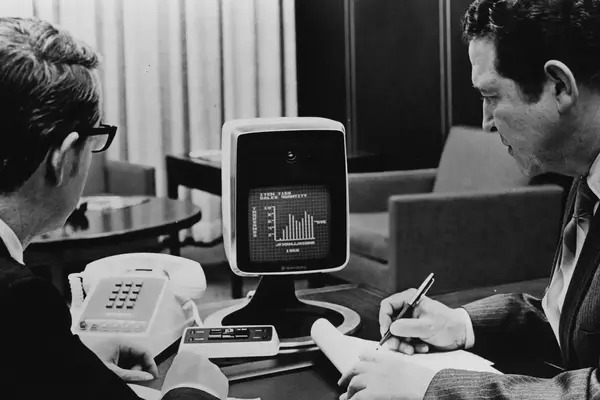Videotelephony, the revolutionary invention ahead of its time, has transformed the way we connect with others. It allows individuals to communicate in real-time through audio and video transmissions, bridging the barriers of distance and creating a global community. In today’s fast-paced world, where communication is crucial, videotelephony has become an essential tool for businesses, governments, and individuals alike.
Table of Contents
Brief overview of videotelephony and its importance in communication
Videotelephony refers to the transmission of audio and video signals in real-time, enabling individuals to have face-to-face conversations despite being in different geographical locations. It has significantly improved long-distance communication, making it more personal and interactive. By capturing facial expressions, body language, and tone of voice, videotelephony replicates the experience of being physically present, enhancing the quality and depth of interactions.
Thesis statement: Videotelephony, developed ahead of its time, revolutionized the way we connect with others.
Videotelephony, often considered an early invention ahead of its time, has truly revolutionized the way we connect with others. It has brought people closer, breaking down the barriers of distance and creating a global network of communication. Through videotelephony, individuals can collaborate, share ideas, and build relationships in ways that were previously unimaginable. This technology has not only transformed personal interactions but has also made a significant impact on various industries such as medicine, education, and entertainment.
Importance of Videotelephony in Communication
Videotelephony plays a vital role in modern communication, enabling businesses and organizations to operate more efficiently and effectively. With the ability to conduct conferences and meetings remotely, videotelephony has revolutionized the way businesses function, allowing for seamless collaboration regardless of geographical constraints. It has also contributed to the rise of remote work, enabling individuals to work from anywhere in the world, increasing productivity and work-life balance. Furthermore, videotelephony has transformed personal relationships, allowing individuals to connect with their loved ones in real-time, regardless of physical distance, fostering stronger bonds and emotional well-being.
In conclusion, videotelephony, an early invention ahead of its time, has revolutionized the way we connect with others. It has bridged the barriers of distance, creating a global community and enhancing the quality of communication. As technology continues to evolve, videotelephony will undoubtedly play a pivotal role in shaping our future, enabling advancements in various sectors and bringing people closer together. The transformative power of videotelephony is undeniable, and its potential for the future is limitless.
History of Videotelephony
The history of videotelephony takes us back to the early 20th century when this groundbreaking technology was first invented and developed. It was during this time that the idea of transmitting live audio and visual signals over a distance started to take shape.
Invention and development of videotelephony
The invention of videotelephony can be attributed to several pioneers and notable figures in the field. One such pioneer was Bell Labs engineer George 0. Squier, who in 1907 developed a system that could transmit images over a phone line. This invention laid the foundation for the development of videotelephony as we know it today.
Challenges faced during the early days
During the early days of videotelephony, there were numerous challenges that needed to be overcome. One major challenge was the limited availability of the necessary infrastructure. The technology required significant bandwidth and specialized equipment, making it inaccessible to the general public. Additionally, the quality of video and audio transmission was often poor, resulting in blurry images and distorted sound.
Despite these challenges, the pioneers of videotelephony persevered and continued to refine the technology. Their efforts laid the groundwork for future advancements and paved the way for the widespread adoption of videotelephony in the years to come.
As videotelephony technology continued to evolve, it became clear that it was an invention ahead of its time. The ability to see and hear someone in real-time over long distances revolutionized the way we connect and communicate. The early pioneers and their relentless pursuit of innovation set the stage for the development of modern videotelephony systems that have transformed various industries and reshaped the world we live in today.
Early Applications of Videotelephony
Videotelephony, although initially ahead of its time, quickly found applications in various sectors. Its early adoption in business and government sectors paved the way for a new era of communication. Through video calls, organizations could hold virtual meetings and conferences, eliminating the need for travel and reducing costs. The ability to see facial expressions and body language made communication more effective and personal.
Furthermore, videotelephony played a crucial role in improving long-distance communication. Prior to its invention, people had to rely on written or audio-only communication methods to connect with those far away. However, with videotelephony, individuals could now have face-to-face conversations, bridging the gaps created by distance. This revolutionized communication, allowing for a more intimate and immediate connection between individuals.
The impact of videotelephony extended beyond business and government sectors. It also had a profound effect on various industries, such as medicine and education. In the medical field, videotelephony enabled doctors to remotely diagnose and treat patients, reducing the need for patients to physically visit healthcare facilities. Similarly, in education, videotelephony facilitated remote learning, enabling students to receive education from anywhere in the world. The ability to see and interact with teachers in real-time created a more engaging and effective learning experience.
Overall, the early applications of videotelephony in business, government, long-distance communication, medicine, and education showcased its potential to transform various industries. Its ability to bridge the gaps created by physical distance and enable instant visual communication made it an invaluable tool. As technology continued to advance, videotelephony would play an even more significant role in connecting individuals and revolutionizing the way we interact with others.
Technological Advancements in Videotelephony
Videotelephony has witnessed numerous technological advancements since its early days. These advancements have led to significant improvements in video and audio transmission quality, facilitating seamless communication across vast distances.
Evolution of video and audio transmission quality has been a key area of development in videotelephony. In the early years, video and audio quality were often compromised due to limitations in technology. However, with continuous innovation and research, video and audio transmission quality has greatly improved. High-definition video and crystal-clear audio are now achievable, providing users with immersive and lifelike telecommunication experiences.
The shift from analog to digital systems has also revolutionized videotelephony. Traditional analog systems were limited in terms of quality and capacity, making them unsuitable for high-quality video transmission. With the advent of digital systems, video signals can be digitized and transmitted more efficiently, resulting in improved video clarity and reduced latency.
The introduction of mobile videotelephony has been a game-changer in the field. With the rise of smartphones and tablets, people can now engage in video calls anytime and anywhere. Mobile videotelephony has not only made communication more convenient but has also had a profound impact on various sectors, such as business, healthcare, and education. It has enabled remote collaboration, virtual consultations, and online learning, opening up new possibilities for connecting people across different locations.
Furthermore, the integration of virtual reality and augmented reality in videotelephony has unlocked even more exciting possibilities. These immersive technologies have the potential to enhance the user experience by providing a more interactive and immersive communication environment. It allows users to engage with virtual objects and environments, making video calls more engaging and dynamic. Whether it’s for virtual meetings, virtual classrooms, or even virtual tourism, the integration of virtual and augmented reality in videotelephony is a glimpse into the future of communication.
In conclusion, technological advancements in videotelephony have propelled it from its humble beginnings to an innovative and powerful mode of communication. The evolution of video and audio transmission quality, the shift from analog to digital systems, the introduction of mobile videotelephony, and the integration of virtual reality and augmented reality have all contributed to transforming how we connect with others. As these technologies continue to evolve, the potential for videotelephony to reshape various industries and create new opportunities is vast.
Societal Impact of Videotelephony
Videotelephony has had a profound societal impact, breaking barriers of distance and creating a global community. The ability to connect with others through video calls has revolutionized communication, allowing people from different parts of the world to interact in real time. Breaking barriers of distance has opened up opportunities for collaboration, education, and cultural exchange that were previously unimaginable.
One of the key areas in which videotelephony has made a significant impact is in enhancing collaboration and productivity in remote work. With the rise of remote work, video calls have become an essential tool for teams to collaborate, brainstorm ideas, and discuss projects. The ability to see and hear each other during meetings and conferences helps to foster a sense of connection and teamwork, even when working from different locations.
Furthermore, videotelephony has transformed personal interaction and relationships. The ability to see and hear loved ones who are far away has made it easier to stay connected and maintain relationships. Whether it is catching up with family members, celebrating milestones with friends, or simply chatting with loved ones, video calls have become an integral part of staying connected in today’s digital age.
Videotelephony has also had a significant influence on entertainment and social media platforms. With the growth of platforms such as YouTube, Twitch, and TikTok, video content has become the most popular form of media consumption. This has led to the rise of vlogging, live streaming, and video-based social media platforms, where individuals can share their experiences, talents, and thoughts with a global audience.
In conclusion, videotelephony has had a multifaceted impact on society. It has broken barriers of distance by creating a global community, enhanced collaboration and productivity in remote work, transformed personal interactions and relationships, and influenced the entertainment and social media landscape. As videotelephony continues to evolve and advance, it will undoubtedly play an even greater role in shaping our society and how we connect with one another.
Future Trends and Challenges in Videotelephony
As videotelephony continues to evolve, there are several exciting future trends and challenges that we can expect to see in the field. Two notable advancements that hold great potential are the development of 5G technology and the integration of artificial intelligence (AI) in videotelephony systems.
The implementation of 5G is set to revolutionize the way we experience videotelephony. With its increased speed and improved network capacity, 5G will allow for seamless high-definition video calls with minimal latency, enhancing the overall user experience. Additionally, 5G’s reliable and secure connection will enable smoother multi-party video conferences, opening up new possibilities for remote collaboration and team meetings.
The adoption of AI in videotelephony is another promising trend. AI-powered features can enhance the quality of video calls by automatically adjusting video parameters, such as lighting and background noise, to ensure optimal visual and audio clarity. Furthermore, AI algorithms can facilitate real-time language translation, making it easier for people from different linguistic backgrounds to communicate effectively. Additionally, AI-driven facial recognition technology can enhance security during video calls by verifying participants’ identities.
Videotelephony also holds great potential in the healthcare and gaming industries. In healthcare, videotelephony can be utilized for remote consultations, allowing patients to connect with doctors from the comfort of their own homes. This can be particularly beneficial for individuals in remote areas, elderly patients, or those with limited mobility. In the gaming industry, players can use videotelephony to communicate and interact with fellow gamers, enhancing the overall gaming experience and fostering a sense of community.
However, along with these exciting advancements, it is crucial to address some of the challenges that come with videotelephony. Privacy and security concerns are paramount, as video calls can potentially be intercepted and sensitive information compromised. It is essential for videotelephony providers to implement robust encryption protocols and ensure user data protection to maintain user trust.
Furthermore, as videotelephony becomes more widespread, it is essential to focus on expanding accessibility in developing regions. Access to stable internet connections and advanced video communication devices can be limited in these areas. Initiatives that aim to bridge this digital divide can help ensure that everyone can benefit from the transformative power of videotelephony.
In conclusion, the future of videotelephony holds great promise. Advancements such as 5G and AI integration will revolutionize the way we communicate and collaborate. The potential applications in healthcare, gaming, and various other industries are vast. However, it is crucial to address privacy and security concerns and work towards expanding accessibility to ensure that videotelephony continues to bring people closer together in an increasingly interconnected world.
Conclusion
In conclusion, videotelephony has proven to be an early invention that was far ahead of its time, revolutionizing the way we connect with others. Its significance in communication cannot be overstated. The development of videotelephony during the early 20th century marked a turning point in the history of communication. Notable figures and pioneers in the field dedicated their efforts to overcome the challenges faced during those early days.
The early applications of videotelephony in business and government sectors showcased its potential in improving long-distance communication. It played a vital role in various industries such as medicine and education, enabling professionals to collaborate and share information in real time. This groundbreaking technology has also brought people together across the globe, breaking barriers of distance and creating a global community.
Technological advancements have played a crucial role in shaping videotelephony over the years. The evolution of video and audio transmission quality, the shift from analog to digital systems, as well as the introduction of mobile videotelephony, have contributed to its widespread adoption. The integration of virtual reality and augmented reality has brought new dimensions to videotelephony, enhancing the overall user experience.
The impact of videotelephony goes beyond just communication. It has transformed personal interactions and relationships, enabling individuals to connect face-to-face regardless of their physical location. It has also influenced entertainment and social media platforms, allowing people to engage with each other in real time. Furthermore, videotelephony has played a significant role in enhancing collaboration and productivity, especially in the remote work era.
Looking into the future, videotelephony holds immense possibilities. Advancements such as 5G and artificial intelligence are set to further enhance the capabilities of videotelephony, opening doors to potential applications in healthcare, gaming, and other industries. However, it is crucial to address privacy and security concerns to ensure the responsible and secure use of this technology. Additionally, efforts should be made to expand accessibility in developing regions, ensuring that everyone can benefit from the transformative power of videotelephony.
In summary, videotelephony stands as an early invention that has had a profound impact on society and continues to evolve. Its significance in communication and the way we connect with others cannot be underestimated. As technology continues to advance, the future possibilities and transformative power of videotelephony are endless, and it is truly an intriguing world to explore.




